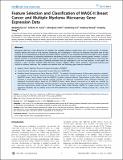| dc.contributor.author | Liu, Qingzhong | |
| dc.contributor.author | Sung, Andrew H. | |
| dc.contributor.author | Chen, Zhongxue | |
| dc.contributor.author | Liu, Jianzhong | |
| dc.contributor.author | Deng, Youping | |
| dc.contributor.author | Huang, Xudong | |
| dc.date.accessioned | 2011-11-22T16:23:01Z | |
| dc.date.issued | 2009 | |
| dc.identifier.citation | Liu, Qingzhong, Andrew H. Sung, Zhongxue Chen, Jianzhong Liu, Xudong Huang, and Youping Deng. 2009. Feature Selection and Classification of MAQC-II Breast Cancer and Multiple Myeloma Microarray Gene Expression Data. PLoS ONE 4(12): e8250. | en_US |
| dc.identifier.issn | 1932-6203 | en_US |
| dc.identifier.uri | http://nrs.harvard.edu/urn-3:HUL.InstRepos:5350702 | |
| dc.description.abstract | Microarray data has a high dimension of variables but available datasets usually have only a small number of samples, thereby making the study of such datasets interesting and challenging. In the task of analyzing microarray data for the purpose of, e.g., predicting gene-disease association, feature selection is very important because it provides a way to handle the high dimensionality by exploiting information redundancy induced by associations among genetic markers. Judicious feature selection in microarray data analysis can result in significant reduction of cost while maintaining or improving the classification or prediction accuracy of learning machines that are employed to sort out the datasets. In this paper, we propose a gene selection method called Recursive Feature Addition (RFA), which combines supervised learning and statistical similarity measures. We compare our method with the following gene selection methods: Support Vector Machine Recursive Feature Elimination (SVMRFE) Leave-One-Out Calculation Sequential Forward Selection (LOOCSFS) Gradient based Leave-one-out Gene Selection (GLGS) To evaluate the performance of these gene selection methods, we employ several popular learning classifiers on the MicroArray Quality Control phase II on predictive modeling (MAQC-II) breast cancer dataset and the MAQC-II multiple myeloma dataset. Experimental results show that gene selection is strictly paired with learning classifier. Overall, our approach outperforms other compared methods. The biological functional analysis based on the MAQC-II breast cancer dataset convinced us to apply our method for phenotype prediction. Additionally, learning classifiers also play important roles in the classification of microarray data and our experimental results indicate that the Nearest Mean Scale Classifier (NMSC) is a good choice due to its prediction reliability and its stability across the three performance measurements: Testing accuracy, MCC values, and AUC errors. | en_US |
| dc.language.iso | en_US | en_US |
| dc.publisher | Public Library of Science | en_US |
| dc.relation.isversionof | doi:10.1371/journal.pone.0008250 | en_US |
| dc.relation.hasversion | http://www.ncbi.nlm.nih.gov/pmc/articles/PMC2789385/pdf/ | en_US |
| dash.license | LAA | |
| dc.subject | computational biology | en_US |
| dc.subject | genomics | en_US |
| dc.subject | metagenomics | en_US |
| dc.subject | systems biology | en_US |
| dc.subject | computer science | en_US |
| dc.subject | applications | en_US |
| dc.title | Feature Selection and Classification of MAQC-II Breast Cancer and Multiple Myeloma Microarray Gene Expression Data | en_US |
| dc.type | Journal Article | en_US |
| dc.description.version | Version of Record | en_US |
| dc.relation.journal | PLoS ONE | en_US |
| dash.depositing.author | Huang, Xudong | |
| dc.date.available | 2011-11-22T16:23:01Z | |
| dash.affiliation.other | HMS^Radiology-Brigham and Women's Hospital | en_US |
| dc.identifier.doi | 10.1371/journal.pone.0008250 | * |
| dash.authorsordered | false | |
| dash.contributor.affiliated | Huang, Xudong | |


